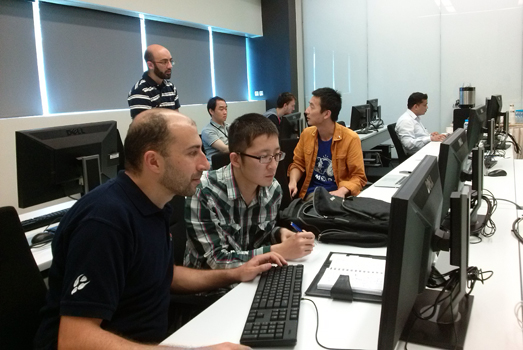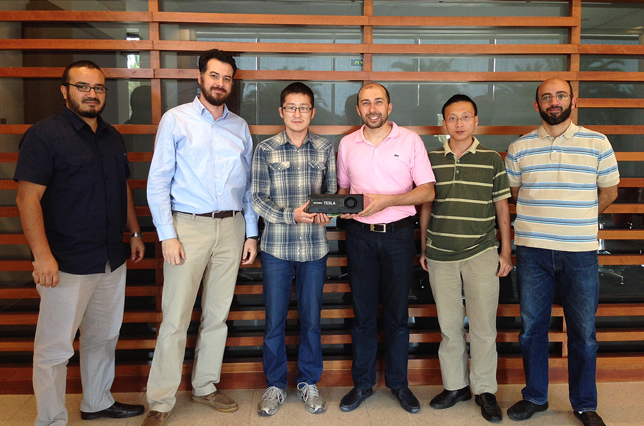First KAUST Hackathon and Second NVIDIA Workshop Bring Computing Talent to Campus

Hackathon participants work on porting their codes and applications to GPUs to accelerate them at KAUST's first hackathon event.
KAUST's Supercomputing Laboratory, in collaboration with NVIDIA, hosted the second KAUST-NVIDIA workshop entitled "Accelerating Scientific Applications Using GPUs" on February 17 on the University's campus.
Held in conjunction with the University's first "hackathon" on February 18-19, the workshop provided its 120 attendees with a general overview of graphic processing unit (GPU) architecture and high-level programming models while focusing on scientific applications ported to GPUs. Technical sessions included an overview of NVIDIA and its collaborators' efforts in porting scientific and engineering applications to GPUs.
The workshop also covered a range of KAUST applications developed on NVIDIA GPUs, including numerical libraries, scientific visualizations, computational chemistry, computational fluid dynamics and seismic imaging and inversion.
A number of speakers from academia, including KAUST Professor David Keyes, KAUST Associate Professor Markus Hadwiger, Dr. Valerio Pascucci, founding director of the Center for Extreme Data Management Analysis and Visualization at the University of Utah, and several KAUST master's and Ph.D. students, gave guest lectures at the workshop. Dr. Timothy Lanfear, manager of NVIDIA's European solution architecture and engineering team, also attended to give a keynote speech to the audience.

Master's degree student Zhendong Zhang (third from left), winner of KAUST's first hackathon, holds his NVIDIA K40 GPU, his prize for winning the hackathon.
Students from other Saudi universities, including King Fahd University of Petroleum and Minerals (KFUPM), Umm Al-Qura University, Effat University and King Abdulaziz University (KAU), and representatives from Saudi Aramco and the Saudi Basic Industries Corporation (SABIC) also came to the workshop.
The hackathon was an exciting opportunity for teams of developers to attend a two-day intensive and hands-on workshop guided by OpenACC and CUDA mentors from KAUST and NVIDIA.
Ten participants forming four teams attended the hackathon, bringing their scientific applications to port to a GPU accelerator. Teams came from KAUST's Spatio-temporal Statistics and Data Analysis Group (headed by Professor Marc Genton), the Clean Combustion Research Center, the Seismic Wave Analysis Group (headed by Professor Tariq Alkhalifah) and SABIC.
The teams targeted four different domain science applications at the hackathon, including statistics, combustion, seismic imaging and molecular dynamics. KAUST mentors assisting at the event were event co-organizers Drs. Saber Feki and Hatem Ltaief, Dr. Bilel Hadri and Ph.D. students Ali Charara and Ahmad Abdelfattah.
"The four exciting teams brought their codes and their applications to port them to GPUs to accelerate them and have better performance," said Dr. Feki, a computational scientist in KAUST's Supercomputing Laboratory.
"Many people are scared of changing codes or using new hardware," noted fellow computational scientist Dr. Hadri. "The hackathon helped show the teams that we can 'democratize' the use of GPUs – you don't need to be an expert to do this, you just need to use the tools at hand, and we were here to help."
The winning team at the hackathon consisted of master's degree student Zhendong Zhang from the Seismic Wave Analysis Group. As a prize he received an NVIDIA K40 GPU sponsored by NVIDIA.
"With initially no experience at all with GPUs, all four teams were successfully running their applications on GPUs by the end of the hackathon," said Dr. Feki. "The seismic imaging group ported their Reverse Time Migration code to GPUs using OpenACC and achieved a performance speedup of 6X."
Drs. Feki and Ltaief added they were pleased the hackathon fostered interdisciplinary research collaborations between two of KAUST's Research Centers, the Extreme Computing Research Center and the Clean Combustion Research Center.
- By Caitlin Clark, KAUST News

